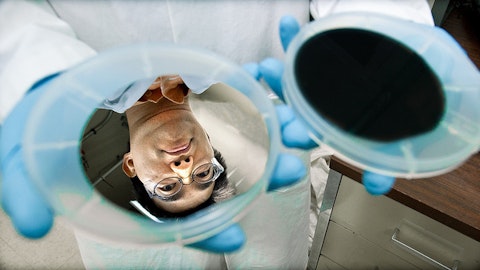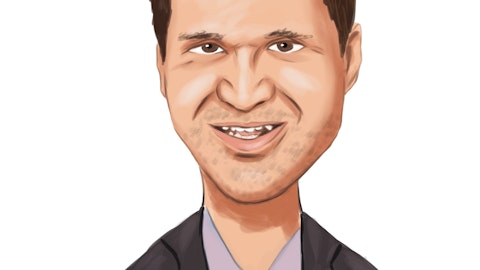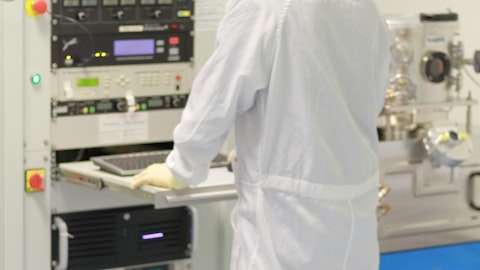Photronics, Inc. (NASDAQ:PLAB) Q4 2022 Earnings Call Transcript December 13, 2022
Operator: Good day and thank you for standing by. Welcome to the Photronic’s Fourth Quarter and Full Year 2022 Earnings Conference Call. At this time, all participants are in a listen-only mode. After the speakers’ presentation, there will be a question-and-answer session. Please be advised that today’s conference is being recorded Tuesday, December 13, 2022. I would now like to hand the conference over to your host, Richelle Burr, Executive Vice President, Chief Administrative Officer and General Counsel. Please go ahead.
Richelle Burr: Thank you, Richelle. Good morning, everyone. Welcome to our review of Photronic’s fiscal 2022 full year and fourth quarter results. Joining me to evaluate ongoing performance and reconciliation of these metrics to GAAP financial results is provided in our presentation peril. At this time, I will turn the Frank over — I will turn the call over to Frank.
Frank Lee: Thank you, Richelle, and good morning, everyone. Q4 was solidly finished to a great year. Revenue grew 24% in 2022 as we achieved our fifth consecutive year of record revenue. Both IC and FPD generated strong growth as design activity remained robust. We saw annual growth across nearly all products types. It remains clear that our broad technology portfolio, operation effects and close customer relationships have met us the market leader. Q4 revenue was less than third quarter revenue, with demand slowing in high-end large lastly. Our investment will be indicated by the current semiconductor industry downturn as design activity remains relatively strong. There was also some negative impact from depreciation of Asian currencies on FPD business.
However, we believe that factor causing this slower demand with the transit, and we maintain our positive view on the long-term demand trend. Gross margin and operation margin was essentially flat compared with the third quarter as we motivate the impact on lower borrowings by closely managing our costs while we continue to benefit from strong pricing. We also realized a foreign exchange gain that John will discuss in more detail later. The end result is we delivered EPS of $0.60 for fourth quarter. Looking now to the industry outlook while we believe the demand trends in addition to customer capacity expansions are intact in the long term. The near-term picture is cloudier due to current market on service. Factors such as high interest rates, rising inflation and slowing GDP are already having a negative impact on some sectors of the electronic product supply chain and could potentially impact photomask demand.

Photo By Vishnu Mohanan on Unsplash
Moreover, adding to uncertainties is that U.S. government’s new export restriction imports from China on certain semiconductor technologies that may further impact the Chinese IC industry. So far, these actions have had minimal impact on Photronics’ business or operations. However, the situation is dynamic and through, which we continue to monitor. At the same time, we will ensure our compliance with all regulations while taking necessary actions to mitigate the impact on our supply chain and business. Although the near term deal is uncertain, we are confident that IC design and manufacture continue to play a central and expanding role in the global economy. Photomask is a key element within the ecosystem. We are continuing to strive over the long term.
Currently, IC manufacturing regionalization is spurring investment across the world. This new capacity will generate additional photomask demand. Performance will capitalize on these opportunities from a position of business and spread. Our customer relationships are beyond trust, supported by our technology, service, quality and global production capacity. This customer relationship coupled with many long term purchase agreement have continued to support our competitive advantage in the business. I would like to thank the entire Photronics’ team for excellent performance in the fourth quarter and throughout the full year. We navigated challenges and change and great opportunities as we deliver another record year. Our long-term strategy is intact and on track to achieve our financial targets.
I’m proud of what we have accomplished together and believe we can do even better in the future. At this time, I will turn the call to John.
See also 12 Best Dividend Paying Stocks To Buy Now and 15 Biggest Gambling Countries in the World.
John Jordan: Thank you, Frank, and good morning, everyone. Revenue in the fourth quarter was lower sequentially as softer demand trends were experienced in both IC and FPD primarily for high-end products. Our product diversity and global customer base helped mitigate high-end with mainstream revenue higher for both IC and FPD. We have invested in tool sets for a broad array of technologies and nodes, enabling us to support our customers’ technology road map across both high-end and mainstream. As a result, fourth quarter revenue of $210 million was down only 4% sequentially despite the declines in high-end product revenue. Our conversion teams have done a great job of working with customers to identify opportunities, and our operations teams were effective in supporting this demand with on-time execution, delivering the highest quality products that enable our customers’ success.
IC revenue of $156 million in the fourth quarter was up 25% year-over-year and down 3% sequentially. Although high-end revenue was lower quarter-over-quarter due to some reduction in agent foundry logic demand. That business has been significantly better than last year’s fourth quarter due to some increases in capacity through the year. Midstream revenue improved on continued strong demand, especially in Asia. FPD revenue of $54 million was down 8% quarter-over-quarter and 3% year-over-year. Demand from mobile display masks was lower as panel makers focus on purchasing current products for new premium smartphones and not releasing new designs. G10.5+ demand was also lower during the fourth quarter. We were successful in picking up mainstream to maintain higher capacity utilization.
Gross and operating margins were essentially flat in the third quarter as improved pricing and continued cost discipline offset the negative impact of lower volumes on operating leverage. Gross margin of 38.2% and operating margin of 28.8% are already within our target model range. Based on our outlook and the continued focus on cost reductions, we expect to continue to deliver margin improvement as our revenue moves into the targeted zones with price increases holding stable in 2023, while the outlook for continuation of premiums may be the certain. Operating expenses decreased compared with the third quarter as we balance the need to maintain margins while also investing in resources to support revenue growth, positioning us to continue to grow both revenue and profit.
Non-operating income of $11 million was primarily due to FX gains primarily resulting from re-measurement of U.S. dollar-denominated balances in following locations into the local functional currencies. Income tax provision of $16 million resulted in an effective tax rate of 25.5% for the fourth quarter and 25% for the full year. Diluted EPS for Q4 was $0.60, an 18% increase over Q3 and 82% increase over the $0.33 of last year’s fourth quarter. Diluted EPS for the whole year of 2022 was $1.94, an increase of 118% over 2021, demonstrating the achievement of the entire Photronics’ team during a challenging and changing year. Cash flow generated from operating activities from $79 million in the fourth quarter bringing the 2022 total operating cash flow to $275 million.
We used this cash to invest in growth by funding capital expenditures of $66 million in the quarter. Full year CapEx was $109 million, net of nearly $4 million in government subsidies. For 2023, regional CapEx to be approximately $130 million as we continue to invest in growth, primarily for high-end and mainstream IC capacity. We also continued to reduce debt during the quarter, bringing total year-end total long-term debt to $42 million, a reduction of $69 million since last year-end. Cash balance at the end of the quarter was $320 million. If we improve short-term investments of $39 million, net cash and short-term investments at the end of the quarter was $316 million. Our balance sheet is strong and flexible, and we’re able to pursue growth investments, both organic and inorganic also being prepared to weather potential future economic challenges and uncertainty.
Before I provide guidance, I’ll remind you that our visibility is always limited as our backlog is typically only one to three weeks and demand for some of our products is inherently uneven and difficult to predict. Additionally, the street high-end masks are high. And as this segment of the business grows a relatively low number, high-end orders can have a significant impact on our quarterly revenue and earnings. Given those caveats, we expect first quarter revenue to be in the range of $203 million to $213 million as we expect positive demand trends with less than typical seasonality. Based on those revenue expectations and our current operating model, we estimate earnings per share for the first quarter to be in the range of $0.40 to $0.48 per diluted share.
2022 was a great year. We grew revenues 24% posting our fifth consecutive year of record revenue, expanded margins, which places us into the bottom end of the range in our target model and strengthened our balance sheet, generating cash, reducing debt and investment in growth. Looking forward, we believe positive long-term market trends and our leadership position together with financial flexibility positions us to continue our profitable growth and achieve even greater success for our customers, our employees and our shareholders. I will now turn over to the operator.
Q&A Session
Follow Photronics Inc (NASDAQ:PLAB)
Follow Photronics Inc (NASDAQ:PLAB)
Operator: Our first question comes from the line of Hans Chung with D.A. Davidson. Your line is open. Please go ahead.
Hans Chung: So first, so it seems like you have a pretty good gross margin for the quarter. And then just wanted to kind of deep dive back what’s the driving factors that I know you mentioned some cost management and then the pricing is still favorable. So just any detail on that? And then how should we think about the gross margin in 2023?
Frank Lee: The pricing environment has been very good, so our pricing is stronger than it has been historically. And we expect that pricing to maintain. We’ve seen even as demand is still strong, but not quite what it has been. The pricing holds up, we have pricing agreements across the Board in Asia, they’ve held, as I mentioned, as demand is not quite as strong. We did — we have had premiums as people gain to move up in extra from mainstream delivery sense has been much more extended than it had been historically. Those premiums are less predictable, but through the fourth quarter, both pricing and premiums have held up. So a combination of change in mix with some of our operations taking up business and improving their margins and with sustained pricing strength, we think we will stay within the margin ranges that we’ve been experiencing.
Hans Chung: Okay. And then next question, just I know you mentioned the recent impact from China, the restriction that minimized our business. So — but you also mentioned there is still some uncertainties. So I just wanted to kind of get more understand the index, what’s the potential risk from new China export control? Or is any indirect impact from that?
Frank Lee: So far, Hans, we’ve been — there are a couple of factors. One is our business in China is primarily mainstream. So — and most of the restrictions that are issued to prevent leading-edge technology from leaking into Chinese military primarily. So those restrictions to some extent, have affected us, but we’ve been able to essentially figure them all to understand and work with them. So, the restrictions have affected us very over the past three years since they started imposing them. I think that if they stay in the leading-edge technologies, we’re going to remain unaffected but we spend a lot of effort to understand the restrictions as they’re imposed and to make sure that we reach today with them a lot. So, so far, not much effect.
There has been some, but very minimum, and we expect that to continue. And as restrictions continue to get issued, we’ll continue to assess how they affect our business and work within new restrictions. Hopefully, we’ll continue to experience the same minimum effect that we had because they’re directly primarily at leading-edge technologies where we’re not engaged.
Chris Progler: This is Chris. I might add one thing to that on the — if there is a positive side to this since the leading edge has been kind of restricted in China, a lot of that capacity can deploy to midrange and mainstream. So that’s creating a fairly healthy design pipeline have been ranging mainstream nodes in China. I’m just seeing that in the local facility. So — and those are sweet spot nodes for us, particularly how we’re tooled up there. So that’s kind of a situation. But fortunately, that’s kind of a positive knockout effect for our local business.
Operator: Thank you. And one moment for our next question. And our next question comes from the line of Gus Richard with Northland Capital Markets. Your line is open. Please go ahead.
Gus Richard: About six months ago, to pan photomask was spun out and sold to private equity. And I’m just wondering, given that transaction been a little bit of time, how has that affected the market or hasn’t it?




